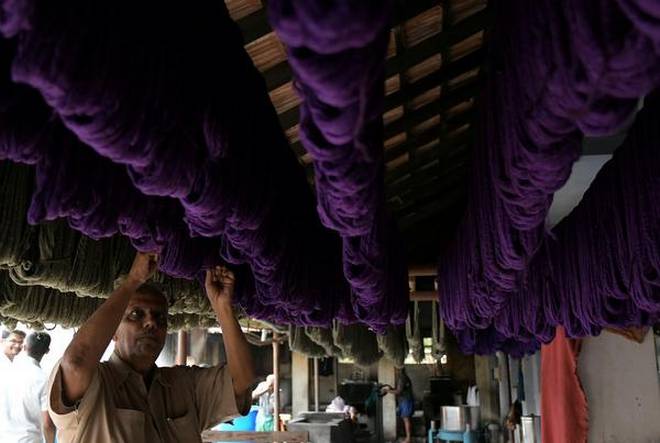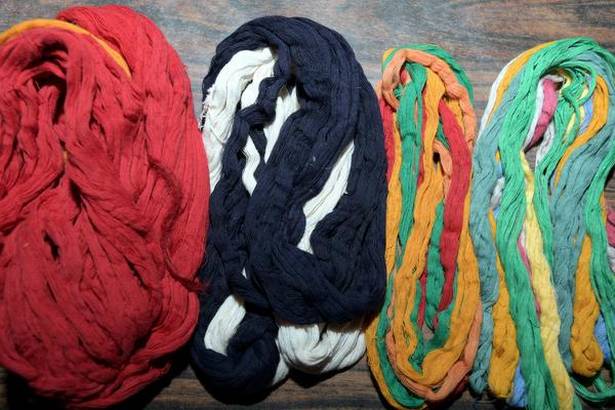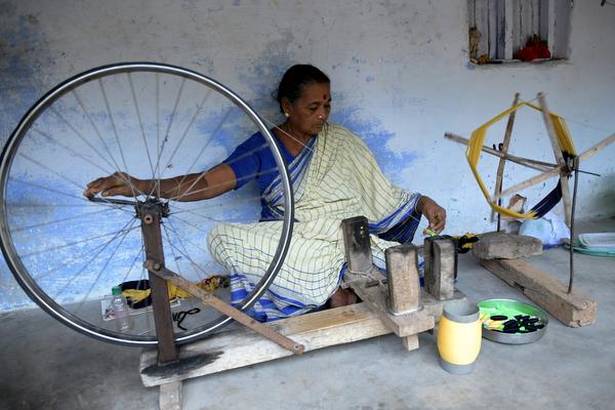
It is now up to the next generation to take this exquisite tradition to the runway
It’s that time of the year when a heavy mist rolls down Sirumalai, and the surrounding hills look forbidding. On the highway leading to Dindigul, streaks of yellow light stain the pre-dawn sky. And some shafts of sunlight stream in through the chipped tiled roof of V. Jeevanandam and J. Bhoomadevi’s home.
Bhoomadevi is already huddled around a bubbling cauldron, making the starch that her husband will use to stiffen yarn.
The previous evening, she bagged the best artisan award from Gandhigram Khadi Trust in Dindigul, a district in south-west Tamil Nadu. She is chuffed by the recognition, but it is time to get to work.
In her home in the Weaver’s Colony, Bhoomadevi opens a suitcase to show me her most prized possessions: Muslin saris that she and her husband have woven. There aren’t too many in the suitcase: because although the couple makes them, they can barely afford them at ₹4,000 to ₹5,000. Sometimes she indulges herself, like last night, when she wore one of these heirlooms to the award function.
The concoction in the cauldron has reached the right consistency and Jeevandam picks up the vessel and in the faint light of street lamps makes his way to the open space outside where a series of wooden structures have been arranged. He and his friends stretch the yarn tautly between pegs and brush the starch on to it. The sun has risen now and the yarn can be dried.
Native over BT
Near the foothills, about 20 km away, at A. Vellode village, G.F. Viswasam, a marginal organic farmer, works the black loamy soil where a tall cotton crop is already bearing plump little buds. This is karungani, a native variety of cotton, which Viswasam adopted despite his community’s scepticism.

He knew the challenges that awaited him: that traders, who preferred BT cotton — considered better suited for powerloom production — won’t be knocking on his door.
But Viswasam was afraid to grow BT cotton. If the rains failed in this dry region, not only would the crop fail, the land would be contaminated with chemical fertilizer rendering it unfit for cultivation.
Karungani on the other hand had deep roots that reached almost two metres deep to tap water, and didn’t need constant irrigation. All it needed was goat dung to thrive.
The only catch was that the native cotton fibre was 24 mm in length on average, compared to BT cotton fibre, which was 34 mm long. But karungani is well suited for handwoven muslin. And thanks to Gandhigram Khadi Trust secretary K. Shivakumar’s love of muslin, Viswasam, Jeevanandam and Bhoomadevi now have assured sources of income.
Gandhigram is now trying to revive interest in this delicate fabric that Europe once imported in copious quantities from India. “It is a niche product and we are striving to keep the tradition alive,” says Shivakumar.
The trust has been conducting workshops for farmers hoping to encourage them to cultivate native cotton because it is better suited for the local climate.
“The muslin saris that we make have a thread count of 100,” he says proudly. Cotton bales are spun into yarn at the Gandhigram mill where machines from the 1950s still run smoothly.
The only thing Gandhigram lacks is a ginning unit to separate the seeds from the fibre and also help create a seed bank of native seeds. A. Prasath, who left his cushy job at Reid and Taylor to be a part of this movement, and C. Saravanan, the master dyer, are tapping into the organic dye industry.

At the dyeing unit at Gandhigram are T-shirts, shawls and stoles, each bearing a tag that says they are organically dyed, ready to be shipped to Europe.
Wanted: designer
Outside the dyeing shed are nuts, tree barks and roots, procured from tribal communities in far away Chhattisgarh, drying in the sun. They will be pounded, ground and boiled to release hidden colours.
P. Palaniammal, a worker at Gandhigram dips yarn into a pot of indigo dye. The yarn turns light green after the first dip, emerald after the second, dark sapphire and then finally a brilliant indigo.
Lalitha Regi, a doctor, is helping the team market this product. What can be better than organic cotton, hand-spun, hand-woven and hand-dyed in organic colours, she asks. But this fabric is in need of a designer who can popularise it. Lalitha has been attending exhibitions to display these unique weaves.
Slowly but surely muslin seems to be coming into vogue. S. Meena, 24, who now works in one of the dyeing units at the Trust, tells me that she spent her first Diwali bonus on a ₹2,600 muslin sari. “Not even a silk sari would have given me so much happiness,” she says. “It is the texture, the satiny feel against the skin and the lightness of the cloth, and the fact that it breathes, that makes this fabric so alive.”
It is six in the evening and Gandhigram is shutting down. But the day has not ended at the Weavers Colony. As the shadows lengthen over the loom, Jeevandam is tying up the warp and weft for tomorrow’s weaving.
I hear the clickety-clack of a lone shuttle somewhere as a radio hums in the distance. It is now for the next generation to carry forward this exquisite tradition, popularise it, and one day maybe even take it to the runway.
source: http://www.thehindu.com / The Hindu / Home> Life & Style> Field Notes> Fashion / by Beulah Rose beulah.r@thehindu.co.in / February 03rd, 2018